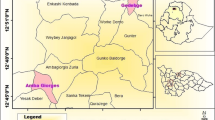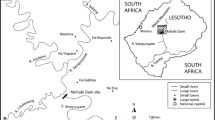Abstract
Aim
Microbial contamination of drinking water at the water source and household storage is the prime reason for the diarrheal prevalence in the developing counties. The goal of the study is to assess the microbial quality of household stored drinking water and its implication on health, particularly diarrhea.
Subjects and methods
To assess the microbial contamination of drinking water in Pallikaranai panchayat union located in southern Chennai, the samples were collected from seven source wells, at the point of distribution and from the household storage for 1–5 days. Total coliform and E. coli are analysed as it is the main indicator of microbial contamination. Most probable number and standard spread-plate method were used to enumerate the total coliform and E. coli bacteria respectively. Data on diarrheal disease were obtained from 290 children, and information on the source of water, household storage vessels and water treatment adopted by the household with recall period of 2 weeks was collected. The study was conducted in 2010 and 2012.
Results
The E. coli and total coliform were detected at the source level and the colony counts were increased gradually at the point of distribution and at the place of household storage. The analysis revealed that out of 26.2 % of respondents depending on the piped water supply, 22.3 % were affected with the diarrheal disease.
Conclusion
Household storage water is more contaminated than the piped water, indicating that interventions are needed to decrease the contamination of water at the place of household storage. The appropriate intervention for the low income category is chlorination and improving personal hygiene behaviour in regards to household water storage.





Similar content being viewed by others
References
APHA (1998) Standard methods for the examination of water and wastewater, 20th edn. American Public Health Association. American Water Works Association. Water Environment Federation Publication, Washington, DC
Banda K, Sarkar R, Gopal S, Govindarajan J, Harijana B, Jeyakumar MB, Mitta P et al (2007) Water handling, sanitation and defecation practices in rural southern India: a knowledge, attitudes and practices study. Trans R Soc Trop Med Hyg 101:1124–1130
Brick T, Primrose B, Chandrasekhar R, Roy S, Muliyil J, Kang G (2004) Water contamination in urban south India: household storage practices and their implications for water safety and enteric infection. Int J Hyg Environ Health 20(7):473–480
Clasen TF, Nadakatti S, Menon S (2006) Microbiological performance of a water treatment unit designed for household use in developing countries. Trop Med Int Health 11:1399–1405
Clasen T, Roberts IG, Rabie T, Schmidt W, Cairncross S (2009) Interventions to improve water quality for preventing diarrhoea (Review). The Cochrane Collaboration. Wiley, Chichester, UK, 52 pp
Esrey SA, Habicht JP (1986) Epidemiologic evidence for health benefits from improved water and sanitation in developing countries. Epidemiol Rev 8:117–128
Fewtrall L, Kaufmann RB, Kay D, Enanoria W, Haller L, Colford JM (2005) Water, sanitation and hygiene intervention to reduce diarrhoea in less developed countries: a systematic review and meta-analysis. Lancet Infect Dis 5:42–52
Kosek M, Bern C, Guerrant RL (2003) The global burden of diarrhoeal disease, as estimated from studies published between 1992 and 2000. Bull World Health Organ 81:197–204
Levy K, Nelson KL, Hubbard A, Eisenberg JNS (2008) Following the water: a controlled study of drinking water storage in northern Coastal Ecuador. Environ Health Perspect 116(11):1533–1540
Mintz ED, Reiff FM, Tauxe RV (1995) Safe water treatment and storage in the home. JAMA 273:948–953
Oswald EW, Lescano AG, Bern C, Calderon MM, Cabrera L, Gilman RH (2007) Fecal contamination of drinking water within peri-urban households Lima Peru. AmJTrop Med Hyg 77(4):699–704
Taulo S, Wetlesen Abrahamsen R, Mkakosya R, Kululanga G (2008) Microbiological quality of water, associated management practices and risks at source, transport and storage points in a rural community of Lungwena, Malawi. Afr J Microbiol Res 2:131–137
Vanderslice J, Briscoe J (1993) All coliforms are not created equal: a comparison of the effects of water source and in-house water contamination on infantile diarrhoeal diseases. Water Resour Res 29:1983–1995
WHO (1984) Guidelines for a sample survey of diarrhoeal disease morbidity, mortality and treatment rates. World Health Organisation Diarrheal Control Program Document, WHO/CDD/SER, Geneva. pp 84–86
WHO (2002) The World Health report 2002. WHO, Geneva
WHO/UNICEF (2009) Diarrhoea: why children are still dying and what can be done. WHO, Geneva
Wright J, Gundry S, Conroy R (2004) Household drinking water in developing countries: a systematic review of microbiological contamination between source and point-of-use. Trop Med Int Health 9:106–117
Yassin MM, Abu Amr S, Najar HM (2006) Assessment of microbiological water quality and its relation to human health in Gaza Governorate Gaza Strip. Public Health 120:1177–1187
Acknowledgements
The author wishes to acknowledge the Wageningen University, Netherlands and SaciWATERs, Hyderabad for providing the research fellowship to carry out the present study. Grateful appreciation is extended to the health offices and the communities of Pallikaranai.
Conflict of interest declaration
The authors declare that they have no conflict of interest.
Author information
Authors and Affiliations
Corresponding author
Rights and permissions
About this article
Cite this article
Lavanya, V., Ravichandran, S. Microbial contamination of drinking water at the source and household storage level in the peri-urban area of southern Chennai and its implication on health, India. J Public Health 21, 481–488 (2013). https://doi.org/10.1007/s10389-013-0573-8
Received:
Accepted:
Published:
Issue Date:
DOI: https://doi.org/10.1007/s10389-013-0573-8




